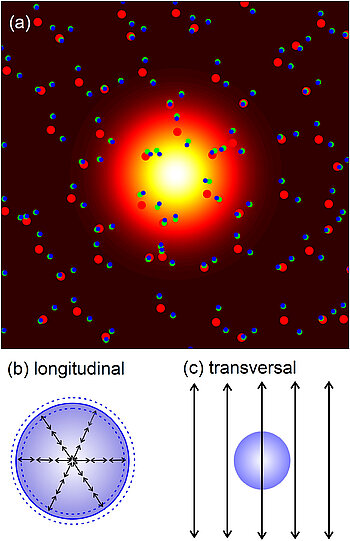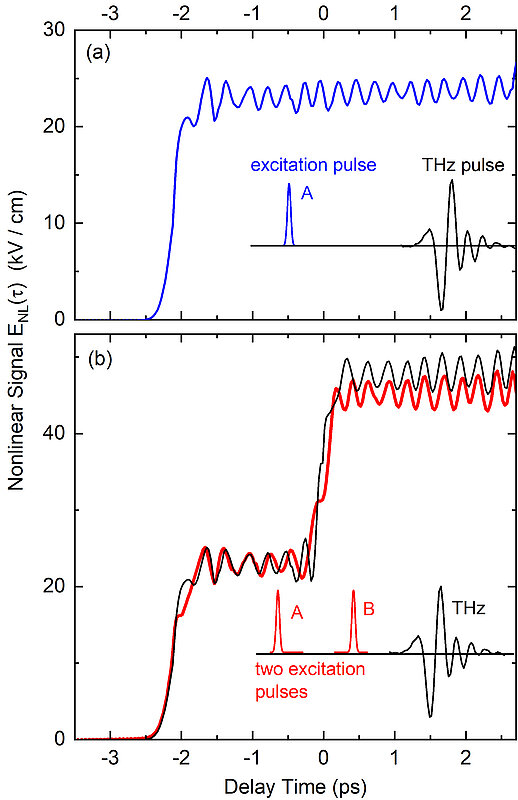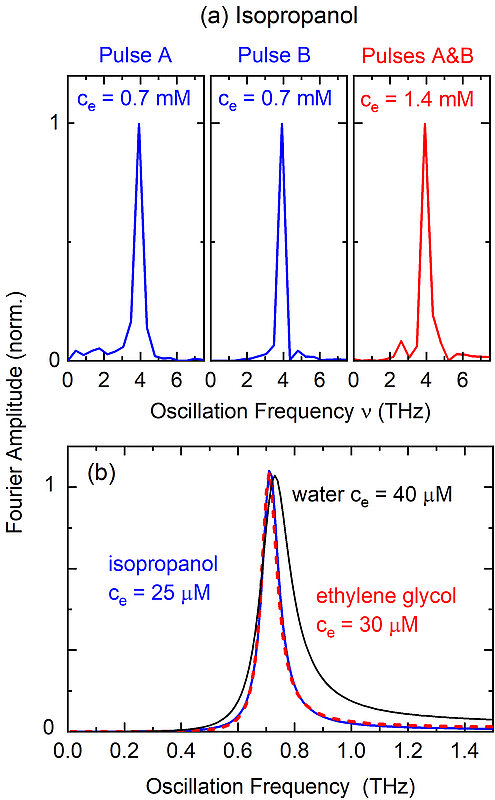The vibrations change the diameter of this sphere periodically for more than 100 picoseconds. New results from ultrafast spectroscopy reveal how such oscillations in radial direction are distinguished from transversal excitations and how the two of them govern the electric behavior of the liquid. Tuning the concentration of generated electrons allows for adapting the electric properties of different liquids.
Polar liquids such as water and alcohols consist of molecules with an electric dipole moment. Via their dipoles, the molecules exert electric forces on each other, by which coupled collective motions of large groups of molecules are rendered possible. Collective motions have a direct impact on electric properties of the liquid, e.g., the microwave absorption, but have been explored to a limited degree only and are not understood at the molecular level.
Ionization of molecules in a liquid by a femtosecond light pulse generates electrons, which are transferred to a localized ground state within several hundreds of femtoseconds. The localized electron is embedded in molecular cloud of nanometer dimension, which encompasses thousands of molecules (Fig. 1a). In the early phase of the localization process, collective coherent vibrations of the molecular cloud, so-called polarons are excited, which manifest in a periodic modulation of optical absorption in the terahertz frequency range (Fig. 2(a), 1 THz = 1012 Hz = 1012 vibrations per second). The oscillation frequency is determined by the electron concentration in the liquid.
New results from the Max Born Institute, Berlin, Germany (Physical Review Research 7, 023304 (2025)) demonstrate that polaron oscillations are connected with radial, that is longitudinal motions of molecules in the cloud (scheme in Fig. 1(b)) and that such oscillations are decoupled from the environment beyond the cloud. The diameter of the cloud is determined by the screening length of the electric field from the central electron, a length of a few nanometer over which this field is present in the liquid.
Experiments, in which electrons were generated by two light pulses separated in time, reveal a polaron frequency determined by the partial electron concentration created by each excitation pulse individually (Fig. 2(b)). After the second excitation, the polaron frequency remains unchanged, although the total electron concentration has doubled (Fig. 3(a)). This surprising observation demonstrates a minor mutual coupling of different vibrating molecular clouds and an effective decoupling from their environment. In contrast, the transversal excitations (Fig. 1(c)) occurring after electron generation are additive on a macroscopic length scale. The related step-like change of THz absorption (Fig. 2(b)) is determined by the total electron concentration in the liquid.
A second study done in collaboration with researchers in the USA and the United Kingdom (Physical Review A 112, L011101 (2025)) shows how to make the electric properties of different liquids nearly identical. Control of the electron concentration in different alcohols results in identical frequencies and line shapes of the polaron resonance (Fig. 3(b)). This 'driven imposter' approach allows for faking the properties of a system by manipulating another one, a concept with potential for applications in optoelectronics and information processing.




